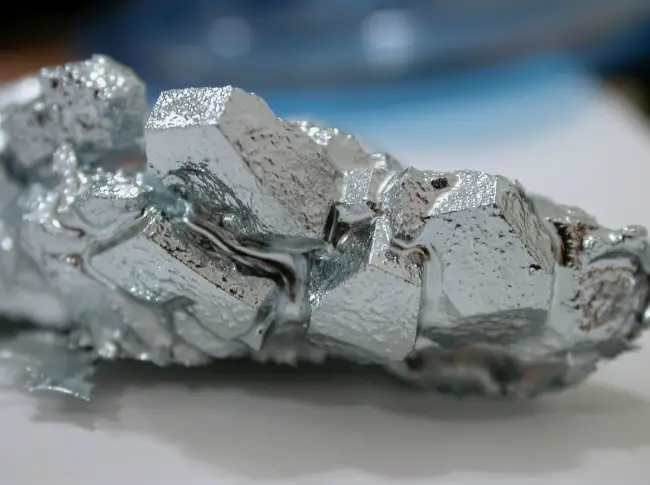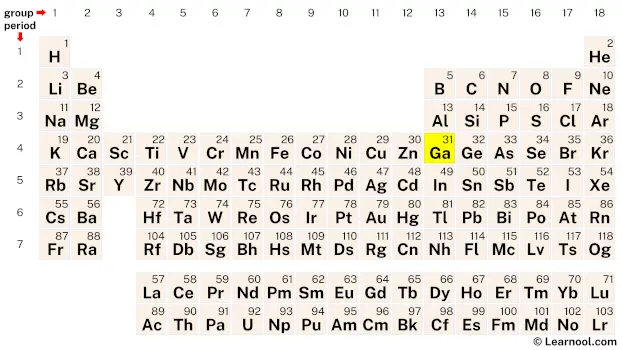
Gallium (Ga) is a chemical element of the periodic table, located in the group 13 and the period 4, and is having the atomic number 31. It is a soft, silvery-white post transition metal, whose name comes from the Latin word “Gallia”, which means France, homeland of the discoverer. It is a member of the boron group.
On periodic table
| group | ⇨ | 1 | 2 | 3 | 4 | 5 | 6 | 7 | 8 | 9 | 10 | 11 | 12 | 13 | 14 | 15 | 16 | 17 | 18 |
| period | ⇩ | ||||||||||||||||||
| 1 | 1 H  Hydrogen |
2 He  Helium |
|||||||||||||||||
| 2 | 3 Li  Lithium |
4 Be  Beryllium |
5 B  Boron |
6 C  Carbon |
7 N  Nitrogen |
8 O  Oxygen |
9 F  Fluorine |
10 Ne  Neon |
|||||||||||
| 3 | 11 Na  Sodium |
12 Mg  Magnesium |
13 Al  Aluminium |
14 Si Silicon |
15 P  Phosphorus |
16 S  Sulfur |
17 Cl  Chlorine |
18 Ar  Argon |
|||||||||||
| 4 | 19 K  Potassium |
20 Ca  Calcium |
21 Sc  Scandium |
22 Ti  Titanium |
23 V  Vanadium |
24 Cr  Chromium |
25 Mn  Manganese |
26 Fe  Iron |
27 Co  Cobalt |
28 Ni  Nickel |
29 Cu  Copper |
30 Zn  Zinc |
31 Ga Gallium |
32 Ge  Germanium |
33 As  Arsenic |
34 Se  Selenium |
35 Br  Bromine |
36 Kr  Krypton |
|
| 5 | 37 Rb  Rubidium |
38 Sr  Strontium |
39 Y  Yttrium |
40 Zr  Zirconium |
41 Nb  Niobium |
42 Mo  Molybdenum |
43 Tc  Technetium |
44 Ru  Ruthenium |
45 Rh  Rhodium |
46 Pd  Palladium |
47 Ag  Silver |
48 Cd  Cadmium |
49 In  Indium |
50 Sn  Tin |
51 Sb  Antimony |
52 Te  Tellurium |
53 I  Iodine |
54 Xe  Xenon |
|
| 6 | 55 Cs  Caesium |
56 Ba  Barium |
72 Hf  Hafnium |
73 Ta  Tantalum |
74 W  Tungsten |
75 Re  Rhenium |
76 Os  Osmium |
77 Ir  Iridium |
78 Pt  Platinum |
79 Au  Gold |
80 Hg  Mercury |
81 Tl  Thallium |
82 Pb  Lead |
83 Bi  Bismuth |
84 Po  Polonium |
85 At  Astatine |
86 Rn  Radon |
||
| 7 | 87 Fr  Francium |
88 Ra  Radium |
104 Rf  Rutherfordium |
105 Db  Dubnium |
106 Sg  Seaborgium |
107 Bh  Bohrium |
108 Hs  Hassium |
109 Mt  Meitnerium |
110 Ds  Darmstadtium |
111 Rg  Roentgenium |
112 Cn  Copernicium |
113 Nh  Nihonium |
114 Fl  Flerovium |
115 Mc  Moscovium |
116 Lv  Livermorium |
117 Ts  Tennessine |
118 Og  Oganesson |
||
| 57 La  Lanthanum |
58 Ce  Cerium |
59 Pr  Praseodymium |
60 Nd  Neodymium |
61 Pm  Promethium |
62 Sm  Samarium |
63 Eu  Europium |
64 Gd  Gadolinium |
65 Tb  Terbium |
66 Dy  Dysprosium |
67 Ho  Holmium |
68 Er  Erbium |
69 Tm  Thulium |
70 Yb  Ytterbium |
71 Lu  Lutetium |
|||||
| 89 Ac  Actinium |
90 Th  Thorium |
91 Pa  Protactinium |
92 U  Uranium |
93 Np  Neptunium |
94 Pu  Plutonium |
95 Am  Americium |
96 Cm  Curium |
97 Bk  Berkelium |
98 Cf  Californium |
99 Es  Einsteinium |
100 Fm  Fermium |
101 Md  Mendelevium |
102 No  Nobelium |
103 Lr  Lawrencium |
|||||
| – p block |
Gallium is a p-block element, situated in the thirteenth column and the fourth row of the periodic table. Its atomic number is 31 and its symbol is Ga.
Element information
 |
|
 |
|
| Origin of name | Latin word “Gallia” (which means France) |
| Symbol | Ga |
| Atomic number (Z) | 31 |
| Atomic mass | 69.723 u |
| Block | p-block |
| Group | 13 (boron group) |
| Period | 4 |
| Classification | Post-transition metal |
| Atomic radius | 135 pm |
| Covalent radius | 122±3 pm |
| Van der Waals radius | 187 pm |
| Melting point | 29.7646 ℃, 85.5763 ℉, 302.9146 K |
| Boiling point | 2400 ℃, 4352 ℉, 2673 K |
| Electron configuration | [Ar] 3d10 4s2 4p1 |
| Learn how to write: Gallium electron configuration | |
| Electrons per shell | 2, 8, 18, 3 |
| Learn how to draw: Gallium Bohr model | |
| Crystal structure | Orthorhombic |
| Phase at r.t | Solid |
| Density near r.t | 5.91 g/cm3 |
| Main isotopes | Gallium-69, Gallium-71 |
| Natural occurrence | Primordial |
| Oxidation state | +3 |
| Electronegativity (Pauling scale) | 1.81 |
| Protons Neutrons Electrons |
31 39 31 |
| Valence electrons | 3 |
| Learn how to find: Gallium valence electrons | |
| CAS number | 7440-55-3 |
| Discovered by | Lecoq de Boisbaudran in 1875 |
History

The history of gallium dates back to 1871 when Dmitri Mendeleev, a Russian chemist, predicted the existence of “eka-aluminium” based on its position in his periodic table. He also made accurate predictions about its properties such as its density, melting point, oxide character, bonding in chloride, and chemical reactions. Mendeleev predicted that eka-aluminium would be discovered using the spectroscope and that metallic eka-aluminium would dissolve slowly in both acids and alkalis and would not react with air.
Gallium was discovered using spectroscopy by French chemist Paul Emile Lecoq de Boisbaudran in 1875. He obtained the free metal by electrolysis of the hydroxide in potassium hydroxide solution and named the element “gallia” after his native land of France. However, it was later suggested that he named it after himself, which Lecoq denied in an 1877 article.
Initially, de Boisbaudran determined the density of gallium as 4.7 g/cm3, which was the only property that failed to match Mendeleev’s predictions. Upon Mendeleev’s suggestion, de Boisbaudran re-measured the density, and the correct value of 5.9 g/cm3, which Mendeleev had predicted exactly, was obtained.
Until the era of semiconductors, the primary uses of gallium were high-temperature thermometrics and metal alloys with unusual properties of stability or ease of melting. In the 1960s, the development of gallium arsenide as a direct bandgap semiconductor marked a significant milestone in the applications of gallium. The electronics industry started using gallium on a commercial scale to fabricate light-emitting diodes, photovoltaics, and semiconductors, while the metals industry used it to reduce the melting point of alloys.
Occurrence and production
Gallium is a relatively rare element and is not found in substantial quantities in any mineral. The primary source of gallium is as a byproduct of aluminum and zinc production. The major producers of gallium are China, Germany, and the United States.
Gallium is typically extracted from the flue dusts that are generated during the processing of zinc and aluminum ores. The flue dust is treated with sulfuric acid to extract the gallium, which is then further purified by a variety of techniques, including fractional distillation and ion exchange. Another source of gallium is the recycling of gallium-containing semiconductor materials.
The worldwide production of gallium is relatively small, with estimates ranging from 300 to 400 metric tons per year. Despite its low production levels, the demand for gallium continues to increase, particularly in the electronics industry, which uses gallium in the production of semiconductors, LEDs, and solar cells.
Properties
Gallium is a soft, silvery-white metal that is liquid near room temperature, with a low melting point of only 29.76 ℃.
It has a low boiling point of 2400 ℃ and a relatively low density of 5.91 grams per cubic centimeter.
Gallium is a post-transition metal and has three valence electrons, making it chemically similar to aluminum.
It is a relatively reactive metal, but forms a protective oxide layer when exposed to air, which prevents further oxidation.
Gallium is a diamagnetic element, which means it is not magnetic, and it is a good conductor of both heat and electricity.
Gallium exhibits a unique property of wetting to many surfaces, even glass, which makes it useful in various applications such as in the production of high-quality mirrors and lenses, semiconductors, and as a component in some types of LED lights.
Applications
Semiconductors
Gallium is commonly used in the production of semiconductors, which are used in electronic devices like transistors, LEDs, and solar cells. Gallium-based semiconductors have unique electrical properties that make them ideal for these applications.
Medicine
Gallium has a radioactive isotope, gallium-67, which is used in medical imaging to detect and locate tumors in the body. It is also used in the treatment of cancer, as it can target and kill cancer cells.
Aerospace
Gallium is used in the aerospace industry to make high-temperature alloys that are resistant to corrosion and oxidation. These alloys are used in the construction of aircraft engines and other critical components.
Thermometers
Gallium is used in thermometers as a non-toxic substitute for mercury. Gallium-based thermometers are more accurate and can measure temperatures over a wider range than traditional mercury thermometers.
Metal alloys
Gallium is often used as an additive in metal alloys to improve their strength and durability. It is commonly added to aluminum, zinc, and other metals to create stronger and more corrosion-resistant alloys.
Nuclear industry
Gallium is used in the nuclear industry as a neutron-absorbing material. It is used to control the rate of nuclear reactions in reactors and to prevent nuclear meltdowns.
Interesting facts
Gallium has a low melting point of only 29.76 ℃, which means it can melt in a person’s hand or at room temperature, and then solidify again once it cools down. This property makes it an interesting element to demonstrate in chemistry classrooms.
Gallium is one of the four elements, along with cesium, mercury, and rubidium, that can become liquid at or near room temperature.
The element was named after the Latin word “Gallia,” which means Gaul, the ancient name for France, where it was first discovered in 1875 by a French chemist named Paul-Émile Lecoq de Boisbaudran.
Gallium is not found in its free form in nature, but is extracted from minerals like bauxite and sphalerite.
Gallium has a very high boiling point, at 2400 ℃, which means it can be used in high-temperature applications, such as in the production of semiconductors.
When exposed to air, gallium forms a protective oxide layer that prevents further oxidation. This property makes it useful in various industries, including electronics, medicine, and aerospace.
Gallium is not toxic, and can even be used in some medical applications, such as in the treatment of certain types of cancer.
Gallium is also used in nuclear medicine, as it can be used to produce isotopes that are used in imaging and therapy.
Related
More elements
External links
- https://www.rsc.org/periodic-table/element/31/gallium
- https://en.wikipedia.org/wiki/Gallium
- https://www.britannica.com/science/gallium
- https://pubchem.ncbi.nlm.nih.gov/element/Gallium
- https://chemistrytalk.org/gallium-element/
- https://education.jlab.org/itselemental/ele031.html
- https://www.livescience.com/29476-gallium.html
- https://www.ducksters.com/science/chemistry/gallium.php
- https://www.chemicool.com/elements/gallium.html
Deep
Learnool.com was founded by Deep Rana, who is a mechanical engineer by profession and a blogger by passion. He has a good conceptual knowledge on different educational topics and he provides the same on this website. He loves to learn something new everyday and believes that the best utilization of free time is developing a new skill.
